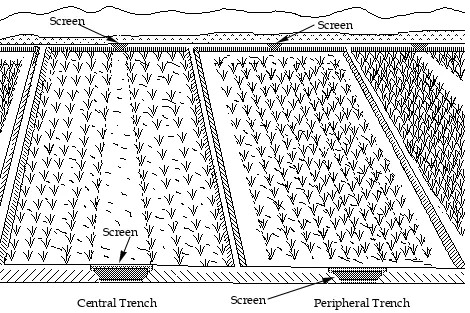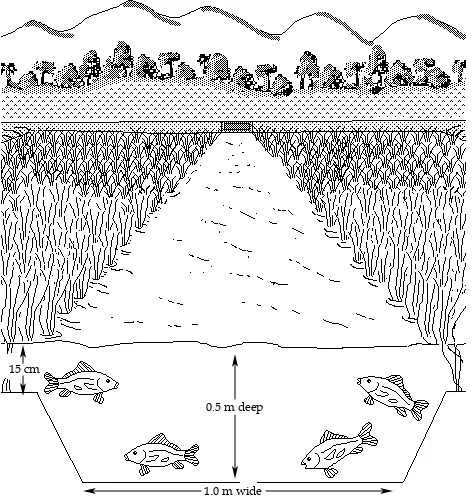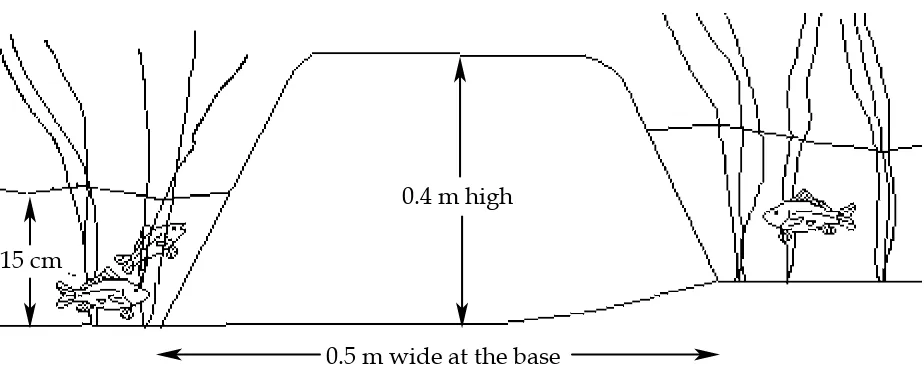WATER HARVESTING AND AQUACULTURE FOR RURAL
DEVELOPMENT
INTRODUCTION TO FISH CULTURE
IN RICE PADDIES
Rice-fish culture is not widely practiced around the world. Most information comes from Asian countries, particularly the Philippines, Indonesia, and Japan, where traditional rice farming methods have been refined over centuries. Rice is the economically important crop. Fish may provide supplemental income and/or protein, but is not normally the primary crop. The addition of fish culture to rice production is an additional management consideration for farmers. In many cases, there may not be sufficient economic justification for this extra management.
Fish culture in rice fields may be practiced at several management levels. In its most simple form, fish stocks are not managed. Wild fish enter the paddy during flooding and are captured at the end of the rice growing season. This method of raising fish together or concurrently with rice is as old as rice culture itself. Other techniques are based on either managed concurrent culture of fish with rice, or on rotational production of fish and rice crops. This manual discusses the concurrent production of rice and fish.
Potential advantages of rice-fish culture
1. Additional food and income in the form of fish.
2. Control of mollusks and insects which are harmful to rice.
3. Reduced risk of crop failure resulting from integration of rice and fish.
4. Continued flooding of the paddy and rooting activity of fish help control weeds. 5. Fish stir up soil nutrients making them more available for rice. This increases rice
production.
Potential disadvantages of rice-fish culture
1. Pesticide use must be restricted.
2. Rice-fish culture may require more water than rice culture alone.
3. Trenches must be dug about 40 to 50 cm below the paddy bottom. In many places, this makes drainage difficult. Rice yield per area is usually reduced because paddy area used for trenches is not planted with rice.
4. Fish produced with the system are often small and total production is lower than what could be produced in a pond of equal size.
5. Because rice production is seasonal, fish are harvested at the same time by every farmer and marketing may be a problem. Consequently, rice-fish culture may be more
appropriate for small-scale paddies where fish are consumed by the producing family. 6. Because rice paddies may be irrigated from a common water supply, it is difficult to
ensure that water used to supply the paddy will be pesticide-free. This may make rice-fish culture impractical.
Paddy Preparation and management
Traditional rice paddies normally require modification for concurrent culture of fish. One important modification is the deepening of part of the paddy to serve as a fish shelter and harvest area. The deepened areas are called trenches, canals, channels, or sumps (Figure 1). Construction and placement vary, but these deepened areas provide several critical elements for successful rice-fish culture:
1) Refuge when the water level is lowered 2) Passageways for fish to find food
3) Easier harvest of fish when the paddy is drained
Screen
Screen Screen
Screen
Central Trench Peripheral Trench
Figure 1: Central and peripheral trenches used in rice-fish culture.
0.5 m deep
1.0 m wide
Figure 2: Trench measurements and water depth in the rice paddy.
Rice husbandry practices that should be followed include rat control, weeding, proper spacing of seedlings, and proper fertilization. Normal weed control and fertilization chemicals are not harmful to fish. Paddy dikes should be high and strong enough to hold water without leaking. Dikes made of good quality clay are best. They should be at least 0.5 m wide and about 0.4 m high (Figure 3).
In some cases, it may be necessary to apply pesticides to the rice crop. This is not recommended while fish are present in the paddy, but the following steps can be taken to minimize the chances of killing fish:
1. Lower the paddy water level to drive fish into the trenches during treatment and for at least 10 days following pesticide application. Two weeks may be considered an average.
2. Prevent contaminated paddy water from entering the trenches. This may be difficult, especially during rains.
3. Apply pesticides at root zone depth or incorporated into the soil to prevent residual wind drift.
4. If insecticides are applied prior to stocking fish, a bioassay may be made on the paddy water with a few fingerlings to see if fish can be safely stocked. If the test fish die, wait several days and test again. Keep testing until water is determined to be safe for fish. See Eliminating Unwanted Fish and Harmful Insects From Fish Ponds in this series for additional details.
15 cm
0.4 m high
0.5 m wide at the base
Place screens across the paddy inlet and outlet to prevent the entry of wild fish and to keep stocked fish in the paddy (Figure 4). Welded screen wire (1 to 2 openings/ cm) set in a wooden frame works well for this purpose. Split bamboo may also be used. Check the screens daily and keep them clean to prevent the paddy from overflowing during heavy rains.
Fish Management
Management activities for fish culture in rice paddies include stocking, fertilization, feeding, water quality control, harvesting, and, restocking. Practices used depend on location, fish species, and numbers of fish stocked. Examples are:
a) Indonesia: Cyprinus carpio (common carp) as the principal species (Source: Huat and Tan 1980).
Paddies have peripheral trenches 30 to 50 cm deep, dikes 25 cm high, with bamboo pipes and screens at water inlets and outlets. Five days after rice transplant fry of 1 cm size are stocked into the paddy at a rate of 60,000/ha. About two weeks later, the paddy is drained for weeding, and fish take refuge in the trenches. The paddy is refilled and, about two weeks later, the rice is weeded again. At this time, fish of 3 to 5 cm are harvested and sold to fish pond owners for culture to market size while larger fish 8 to 10 cm are restocked into the paddy at a rate of 1,000 to 2,000/ha. Fish and rice are grown for an additional 1.5 to 2 months. At harvest, fish weigh 50 to 75 g and are 14 to 16 cm in length. Total fish yield is 75 to 100 kg/ha.
b) Indonesia: Cyprinus carpio (common carp) as the principal species (Source: Cruz and de la Cruz, 1991)
Research was done with 9 farmers from the Totap Mojawa, Simulungun District of North Sumatra. Paddy dikes were raised to allow a minimum water depth of 40 cm. Standing rice stubble remained in the paddy, and loose rice straw was stacked in small mounds. Fingerlings weighing between 52.9 and 111.2 g were stocked at densities of 1,500, 3,000, and 4,500 per hectare in nine rice paddies. Each density was replicated 3 times. Supplemental feeding at 5% of fish biomass/day with a feed composed of rice bran (72%), copra meal (20%), and soybean meal (8%) was adjusted weekly. Paddies were drained , and fish sampled after 35 days to assess growth. Then, they were refilled and and restocked with the same fish. Fish were cultured for an additional 40 days, and then harvested. This 75- day trial was done during the long fallow period between two rice cropping seasons (Table 1).
Table 1: Results of fish culture in rice fields for a 75-day period in Indonesia.
Avg. fish weight (g)
c) Japan: Cyprinus carpio (common carp) as the principal species (Source: Coche 1967).
Paddy dikes are 40 to 45 cm high and 30 cm wide. A 60-cm deep sump several square meters in area is dug near the water inlet. Several channels 30 cm wide are dug from the sump to opposite ends of the paddy. Bamboo screens encircle the water inlet and outlet. From 3,000 to 6,000 fry/ha are stocked into the paddy 7 to 10 days after rice transplant. Paddy water depth is regulated between 6 to 18 cm during fish culture. Fish are given daily supplemental feedings of silkworm pupae. Fish are harvested one week before rice harvest. They are overwintered in ponds, and restocked into rice paddies for a second year of growth. First year yield can be 700 to 1,000 kg/ha with fish of 30 to 60 g average weight. Second year yield may be 750 to 1,100 kg/ha with fish of 100 to 250 g average weight.
d) Madagascar: Cyprinus carpio (common carp) as the principal species (Source: Coche 1967).
Rice seedlings are transplanted into paddies from October to November. A mixture of 200 common carp fry, 150 yearling common carp and 100 to 400 goldfish fry per hectare are stocked into the paddy during February to March. The paddy is drained and rice is harvested one month after stocking fish. The paddy is reflooded and serves as a temporary pond where the fish are cultured for an additional 5 months. The total fish yield may reach 200 kg/ha with common carp weighing 20 to 250 g and goldfish of various sizes.
e) Philippines: Cyprinus carpio (common carp) as the principal species (Source: Arce and de la Cruz 1977).
f) Philippines: Oreochromis niloticus (Nile tilapia) as the principal species (Source: Arce and de la Cruz 1977).
Paddy preparation and water bioassay are described in e above. If the water is safe, 5,000 tilapia fingerlings/ha are stocked into the trench. Paddy management and supplemental feeding after stocking are the same as for common carp. Fish growing season is 70 to 100 days and the expected fish yield is 100 to 200 kg/ha.
g) Philippines: Oreochromis niloticus (Nile tilapia) and Cyprinus carpio (common carp) in polyculture (Source: Arce and de la Cruz 1977).
Paddy preparation and water bioassay are described in e. Carp and tilapia are stocked at a rates of 2,000 and 4,000/ha, respectively. Expected fish yield is from 200 to 300 kg/ha.
h) Philippines: monosex male Oreochromis mossambicus (Mossambique tilapia) as the principal species. (Source: Grover 1979).
Paddy preparation and management is the same as described in e. Fish are sexed by visual examination of the genital papillae and stocked at densities of 25 and 50 kg/ha in different paddies. Yields for each stocking density ranged from 42 to 115 kg/ha with average individual weights of 34 to 40 g.
Glossary
bioassay - a test, using fish as a test animal, performed to determine if water is safe to stock with fish.
fish biomass - the weight of living fish in a pond.
concurrent rice-fish culture - the simultaneous culture of fish and rice together in the same paddy.
trench or canal or sump - a hole or ditch dug in a paddy to provide shelter for fish and facilitate their harvest.
toxicant - a substance that, when applied to a rice paddy, kills insects and other pests, but may also kill fish.
Aquaculture Engineering (with emphasis on small-scale aquaculture projects). Volume 2 - Technical report. United Nations Development Programme, Food and Agriculture Organization of the United Nations. P.O. Box 1184, M.C.C., Makati, Metro Manila, Philippines. P 335-346.
Coche, A.G. 1967. Fish culture in rice fields: a world synthesis. Hydrobiologia 30(1):1 - 44.
Cruz, E.M., and C.R. Dela Cruz. 1991. Production of common carp (Cyprinus carpio) with supplemental feeding in ricefields in North Sumatra, Indonesia. Asian Fisheries Science 4(1991): 31-39. Asian Fisheries Society, Manila, Philippines.
Grover, J.H. 1979. Rice-fish culture and the green revolution. Advances in Aquaculture. Food and Agriculture Organization of the United Nations. Fishing News Books Ltd. Farnham, Surrey, England. P 223-224.
Huat, K.K. and E.S.P. Tan, 1980. Review of rice-fish culture in Southeast Asia. In: Pullin, R.S.V. and Z.H. Shehadeh, Editors. 1908. Integrated
agriculture-aquaculture farming systems. ICLARM Conference Proceedings 4, 258 p.
International Center for Living Aquatic Resources Management, Manila and the Southeast Asian Center for Graduate Study and Research in Agriculture, College, Los Baños, Laguna, Philippines.
Funding for this series was provided by the United States Agency for International Development. Communication regarding this and other technical manuals on water harvesting and aquaculture should be addressed to:
Alex Bocek, Editor
International Center for Aquaculture and Aquatic Environments Swingle Hall
Auburn University, Alabama 36849-5419 USA
Suzanne Gray, Illustrator



